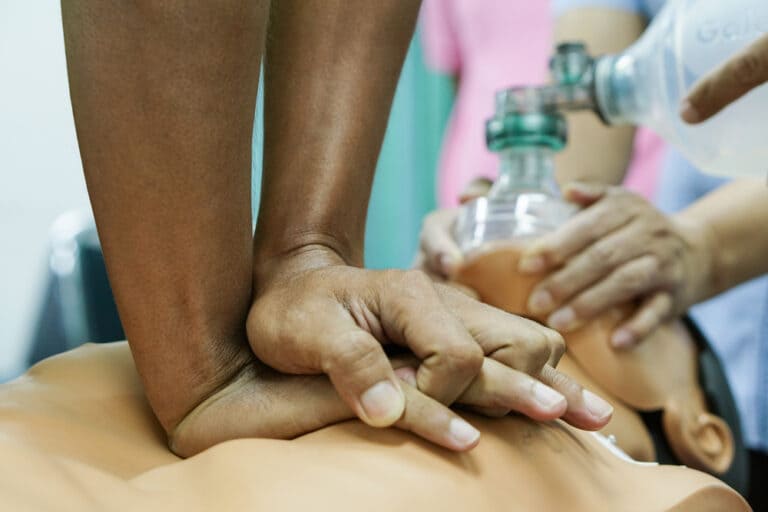


One of the cardinal rules for CPR, especially when a patient who has collapsed is quite elderly, is not to rush to give CPR by default. A lot of people feel a great deal of discomfort with this dictum. They feel as if it is cruel to leave a geriatric person to die without their help.
Especially if you are untrained in CPR, and are a bystander in a situation where a senior citizen seems to have had a cardiac arrest (heart attack) or pulmonary arrest (lung function failure), you don’t know if it’s safe to do CPR. Yet there is some guilt about not following the principles of ethics − and just standing by, watching but not helping.
Of course, it is imperative to immediately call for an ambulance and professional medical help. But then what do you do if help takes a long time to arrive?
Most CPR courses and certification programs would teach you about the risks and benefits of CPR on old people. In many cases the risks of CPR on those past 70 years far outweighs the benefits. If you are not yet formally trained in CPR practices, we hope this article we have written will serve as primary information for you to know about the pros and cons of CPR for elders.
Shereen Jegtvig of Reuters Health reports a study led by Dr. Dionne Frijns, a geriatric medicine researcher at Diakonessenhuis Hospital in Utrecht, the Netherlands.
In this research, they found that about 40 percent of the patients studied had successful CPR (i.e., they had a “return of spontaneous circulation”) − but more than half of those patients ultimately died in the hospital.
For patients aged 70 to 79, the rate of survival to discharge was about 19 percent, for patients aged 80 to 89, the rate was 15 percent and less than 12 percent of patients over the age of 90 were eventually discharged.
Another study paper titled “Quality of life after in-hospital cardiopulmonary resuscitation for patients over the age of 80 years” (published in the Postgraduate Medical Journal and authored by Eleanor Burden et al) makes a very important point about CPR for patients in the high age groups.
To quote the authors: “Our results have shown that there is a risk of substantial functional decline associated with successful CPR in those patients over the age of 80 years. The majority of patients and relatives contacted after successful resuscitation expressed a negative view of the experience. Our study highlights the importance of having early informed discussions with patients and families about CPR in order to avoid detrimental outcomes and ensure patient wishes are correctly represented.”
Quite often, we all see on TV serials how a young person “did the right thing” and saved a senior person’s life after a heart attack with unrelenting CPR. The aggressive compressions and rescue breathing seem heroic. But this kind of dramatic scene is not what may happen in real life.
In real life, the CPR process can actually be brutal on the seniors, as some geriatric specialists explain – and besides, the survival rates are low.
CPR means pushing down into the chest at least 2 inches deep and at least 100 -120 times per minute. With the addition of rescue breathing (especially with apparatus like bag masks) air has to be forced hard into the frail patient’s lungs.
Then, when medical help arrives, an AED (Automated External Defibrillator) may be used to give electrical shocks, or defibrillation, to help the heart re-establish an effective rhythm.
Even if all this CPR is successful, the post-CPR trauma to senior citizens often includes broken ribs, bruised lungs, airway damage, and at times, even internal bleeding.
UCLA Health have on their website a valuable guide developed by Coalition for Compassionate Care of California. This PDF guide has listed those among the older population least likely to benefit from CPR. Here are the categories of people they have identified:
There is a compassionate concept in many Western countries called DNR (“Do Not Rescue”) whereby very old patients, their families and their doctors can all discuss and let the patient make an important decision.
The patients are told of all the risks and benefits of CPR – especially about how the risks may outweigh the benefits in terms of damage to vital organs of the body or possible brain impairment or drastic reduction in quality of life after CPR. The patients are then allowed to make a choice to opt for DNR.
Opting for DNR means that the elder person signs a legal consent to not be given CPR if found in cardiac or pulmonary distress, and if they stop breathing or if their heart stops beating. By default, people around the patient are mandated by law and ethics to try and give CPR. But if the patient has signed the DNR (and wears a DNR bracelet) bystanders or medical professionals will know they do not want to be give torturous CPR.
(Note: Patients can change their mind at any time and update their consent forms as needed.)
It’s important to note that opting for the DNR is a decision ONLY about CPR (cardiopulmonary resuscitation). It is not a consent to stop any other treatments, such as pain medicine, other medicines, or nutrition.
In India, some initiatives have begun towards introducing the DNR concept, although it is all in a nascent form. The Science Section of the online newsmagazine, TheWire.in, in an article titled “New ‘Don’t Attempt Resuscitation’ Rules Don’t Guarantee Right to Dignified Death” by Dr. Saif Razvi, states that in May 2020, the Indian Council of Medical Research (ICMR) published its long-awaited ‘do-not-attempt resuscitation’ (DNA-R) guidelines.
A beginning has been made, even if we have to go a long way yet in converting this initiative into usable law.
With the people of advanced age, it is sometimes more humane not to give CPR. Formal training in CPR best practices helps you know what to do. Here’s our clarion call you too can follow: “Be CPR-aware. Save lives. Be a Heartstrong Hero.”